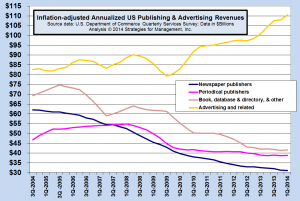The "content is king" mantra keeps taking a beating in terms of the revenues of publishers. As I detailed in Spring of 2012, it seemed that if content was king, it was of a small country, and those publisher revenues keep getting smaller. The chart below shows the latest revenue data, on an inflation-adjusted basis, for ad agencies and publishers. Note how ad agency revenues are rising. While there have always been agencies that specialize in certain media, like television, direct mail, or others, the industry is media agnostic in the aggregate. Its job is to increase the positive visibility of its clients and help spur their customers into action.

This chart below shows the shift on a per capita basis (per person) based on US population for selected years since 2004. Note the decline in publishers and the increase in agencies on this basis. (click to enlarge)

Agencies are now active in social media and less active in other formats that do not require the purchase of time (broadcast) or space (print ads, billboards). They are more active in finding sponsorships of events, and in the staging of events, especially online. Social media requires constant engagement with the audience, and agencies provide the personnel that assume those responsibilities on behalf of their clients. Last week, I attended a presentation by the McKinney agency whose executives discussed their work for Travelocity. The agency sets the tone for the Travelocity gnome, and two of their personnel had the responsibility of engaging customers in Twitter, Facebook, Instagram, and other formats. Contrary to the assumption that social media programs are quick and cheap, their latest one was six months in the making, coordinating all of the ways that clients and prospects would interact with the company, and assuring a consistent approach that supported the themes. Consistency and frequency are key elements of social media campaigns. Few companies have the ability to supply both in advertising functions, but agencies find ways to do so. A recent study by Accenture underscored the greater satisfaction of using outside resources like agencies. The study found that companies that brought these resources inside, probably to save money, were less happy in the long run. Agencies thrive on their creativity for their clients, but social media also means that the creativity has to be implemented well. It's a specialty inside agencies that only comes about because of practice with many clients. Social media is still new, which means diverse experience among industries, products, and social formats is very important. In the past, experience was measured in years; in today's media, it's measured by the number and range of experiences. Single company experience ends up limiting creativity. The last thing one needs in a dynamic media environment is a creative bureaucrat. The report also notes the significant differences in media understanding by CMOs who were 50 years old and under and older ones. More than 70% of the younger ones aggressively pursue mobile media as critical to reach the markets. The others are at 50%. I wonder what the data are like for the 40 year old executives. Make sure your companies have a wide range of ages in the management ranks who see and experience the marketplace in different ways. MediaPost had two good columns about the Accenture study. One focused on the shift in media mix to digital, and the other about how to adapt to changes. For those printing organizations that believe they are marketing service providers, the Accenture report is essential reading. The report indicates that using outside resources creates more satisfaction, and deals with talent shortages in digital media. Implementation of plans is still a problem for many CMOs. Getting things done with the right people and resources within the right time is what CMOs need. Can you provide that? Download the report and the infographic. If you have a wide format printer, print out the infographic and review it at your next staff meeting. Discuss the report with clients and ask them what they think about it and if it describes what's going on in their companies. # # #














